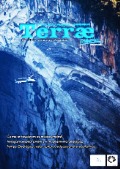Abstract
A descoberta do tempo geológico revolucionou o pensamento científico e conduziu ao desenvolvimento das modernas Ciências da Terra. Apesar disso, pouca atenção é dada para as consequências culturais e sociais de longo alcance do tempo geológico, que vão bem além de sua influência sobre as Geociências. Este ensaio resume a literatura que descreve a dificuldade que os estudantes encontram para compreender o tempo profundo, fornece uma visão geral do desenvolvimento histórico e a relevância cultural do tempo profundo, e sugere maneiras de aumentar a compreensão dos alunos sobre o significado do tempo geológico.References
ARCHER, D. 2005. The fate of fossil fuel CO2 in geologic time. Journal of Geophysical Research, 110.
AULT, C.R., Jr. 1982. Time in geological explanations as perceived by elementary-school students. Journal of Geological Education, 30:304–309.
BORODITSKY, L. 2000. Metaphoric structuring: Understanding time through spatial metaphors. Cognition, 75:1-28.
CARLYLE, T. 1832. Fraser’s Magazine. May 406/1, in Oxford English Dictionary: http://dictionary.oed.com/cgi/entry/20002670?single=1&query_type=word&queryword=deep+time&fi rst=1&max_to_show=10. Accesso em 29.05.2009.
CERVATO, C. et al. 2005. Humanizing science to improve undergraduate education: Short stories on geologic time. Geological Society of America Abstracts with Programs, 37(7):153.
COLEMAN, J.M., ROBERTS, H.H., and STONE, G.W. 1998. Mississippi River Delta; an overview. Journal of Coastal Research, 14:698-716.
DAY, J.W. et al. 2007. Restoration of the Mississippi Delta: Lessons from Hurricanes Katrina and Rita. Science, 315:1679-1684.
DODICK, J. 2007. Understanding evolutionary change within the framework of geologic time. McGill Journal of Education, 42:245-264. Downloaded from specialpapers.gsapubs.org 06.06.2012.
DODICK, J., ORION, N. 2003a. Cognitive factors affecting students’ understanding of geological time. Journal of Research in Science Teaching, 40:415-442.
DODICK, J., ORION, N. 2003b. Measuring student understanding of geological time. Science Education, 87:708-731.
DODICK, J., ORION, N. 2006. Building an understanding of geological time: A cognitive synthesis of the macro and micro scales of time. In:Manduca C.A., Mogk D.W. Ed. Earth and Mind: How Geologists Think and Learn about the Earth. Geological Society of America, Special Paper 413, p.77-94.
FOLTZ, B.V. 2000. Inhabitation and orientation: Science beyond disenchantment. In: Frodeman, R. Ed. Earth Matters. New Jersey: Upper Saddle River, p.25-34. (The Earth Sciences, Philosophy, and the Claims of Community).
FRIEDMAN, W.J. 2005. Developmental and cognitive perspective on humans’ sense of times of past and future events. Learning and Motivation, 36:145-158.
FRODEMAN, R. 1995. Geological reasoning: Geology as an interpretive and historical science. Geological Society of America Bulletin, 107:960-968.
FRODEMAN, R. 2003. Geo-Logic: Breaking Ground between Philosophy and the Earth Sciences. Albany: State University of New York Press, 192p.
GALLUP. 2004. Third of Americans say evidence has supported Darwin’s evolution theory. http://www.gallup.com/poll/14107/Third-Americans-Say-Evidence-Has-Supported-Darwins-Evolution-Theory.aspx Accesso 25.06.2008.
GOULD, S.J. 1987. Time’s Arrow, Time’s Cycle: Myth and Metaphor in the Discovery of Geological Time. Cambridge, MA: Harvard University Press, 240p.
HEGEL, G.F.W. 1977. The Phenomenology of Spirit. Oxford, UK: Oxford University Press, 632p. (Tradução por A.V. Miller).
HEIDEGGER, M. 1962. Being and Time. London: SCM Press, 589p. (Tradução por J. Macquarrie, E. Robinson).
HEILBRON, J.L. 2002. History in science education,with cautionary tales about the agreement of measurement and theory. Science and Education, 11:321-331.
HSÜ, K.J. 1983. The Mediterranean was a Desert. Princeton, NJ: Princeton University Press, 216p.
KANT, I. 1881. Critique of Pure Reason. London: Macmillan, 785p. (Tradução por F.M. Müller).
KERMODE, F. 1967. The Sense of an Ending: Studies in the Theory of Fiction. Oxford, UK: Oxford University Press, 200p.
KOLB, C.R., VAN LOPIK, R. 1996. Depositional environments of the Mississippi River deltaic plain, southeastern Louisiana. In: SHIRLEY, M.L. Ed. Deltas in their geological framework. Houston, TX: Houston Geological Society, p.16-61.
LEVSTIK, L.S., BARTON, K.C. 2005. Doing History: Investigating with Children in Elementary and Middle Schools. 3a ed. Mahwah, NJ: Lawrence Erlbaum Associates, 256p.
LIBARKIN, J. et al. 2005. Qualitative analysis of college students’ ideas about the Earth: interviews and open-ended questionnaires. J. Geosc.. Educ., 53:17-26.
LIBARKIN, J., KURDZIEL, J.P., ANDERSON, S.W. 2007. College student conceptions of geological time and the disconnect between ordering and scale. J. Geosc. Educ., 55:413-422.
MATTHEWS, M.R. 1994. Science Teaching: The Role of History and Philosophy of Science. New York: Routledge, 287p.
MCCLURE, S. et al. 2004. Separate neural systems value immediate and delayed monetary rewards. Science, 306:503-507.
MCINTYRE, A. 1981. After Virtue: A Study in Moral Theory. Notre Dame, IN: University of Notre Dame Press, 252p.
MCPHEE, J. 1981. Basin and Range. New York: Farrar, Straus and Giroux, 224p.
MONECKE, K. et al. 2008. A 1,000-year sediment record of tsunami recurrence in northern Sumatra. Nature, 455:1232-123.
PENN, D. 2003. The evolutionary roots of our environmental problems: Towards a Darwinian ecology. The Quarterly Review of Biology, 78:275-301.
SADLER, P., CERVATO, C. 2011. Data and tools for geologic timelines and time scales. In: Keller, G.R., Baru, C. Ed. Geoinformatics. Cambridge, UK: Cambridge University Press, p.145-165.
SCHOON, K.J. 1992. Students’ alternative conceptions of Earth and space. J. Geosc. Educ., 40:209-214.
SHEA, J. 2001. Teaching the mathematics of radiometric dating. J. Geosc. Educ., 49:22-24.
STENO, N. 1669. De Solido intra Solidum Naturaliter contento Dissertationis Prodromus (Introduction to a Dissertation on Solids Naturally Contained within Solids). Florence: Stellae, 78p.
TOOBY, J., COSMIDES, L. 1995. The psychological foundations of culture. In: Barlow J., Cosmides L.,
TOOBY, J. Ed. The Adapted Mind: Evolutionary Psychology and the Generation of Culture. New York: Oxford University Press, p.19-136.
TREND, R.D. 2001. Deep time frameworks: A preliminary study of U.K. primary teachers’ conceptions of geological time and perceptions of Geosc. Journal of Research in Science Teaching, 38:191221.
TVERSKY, A., KAHNEMAN, D. 1974. Judgment and uncertainty: Heuristics and biases. Science, 185:1124-1131.
UNITED STATES OF AMERICA. National Research Council. 1996. National Science Education Standards. Washington, D.C.: National Academy Press, 262p.
USSHER, J. 1650. Annales veteris testamenti, a prima mundi origine deduction. (Edição moderna em ingles: Annals of the Old Testament, Deduced from the First Origins of the World, editado por L. Pierce and M. Pierce. Green Forest, AK: Master Books, 2003, 960p.).
ZEN, E. 2001. What is deep time and why should anyone care? J. Geosc. Educ., 49:5-9.
A Terrae Didatica utiliza a licença do Creative Commons (CC), preservando assim, a integridade dos artigos em ambiente de acesso aberto.

